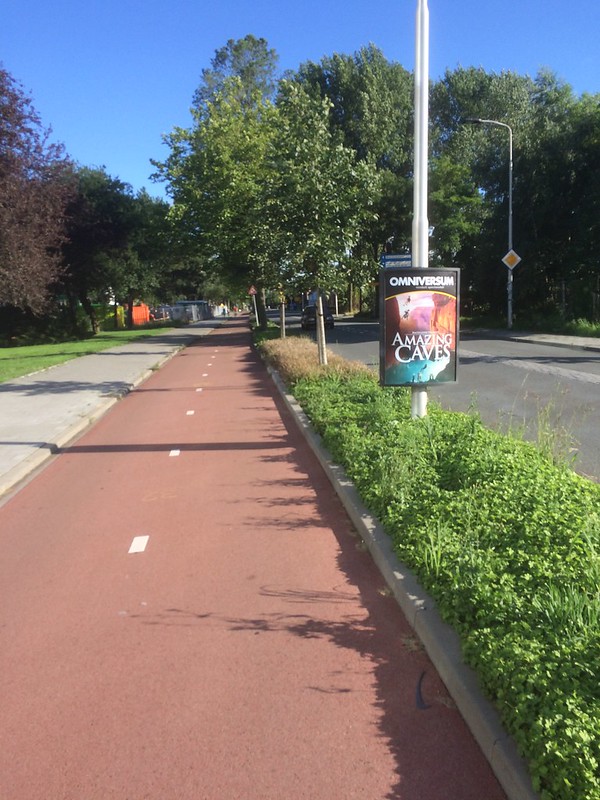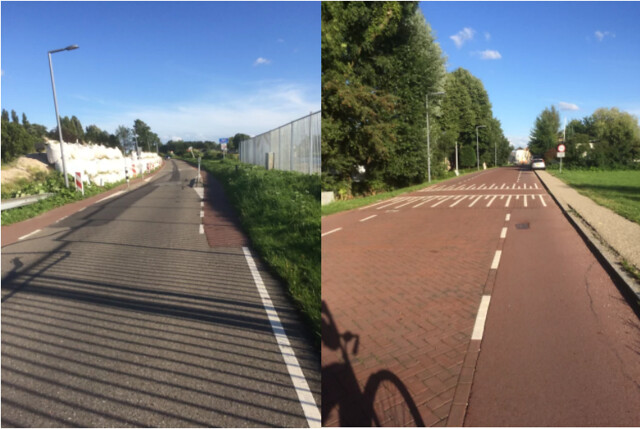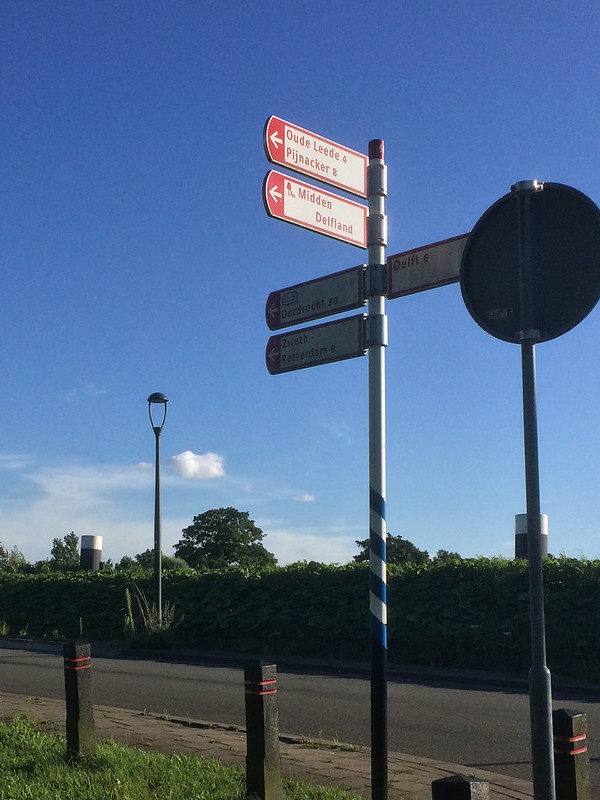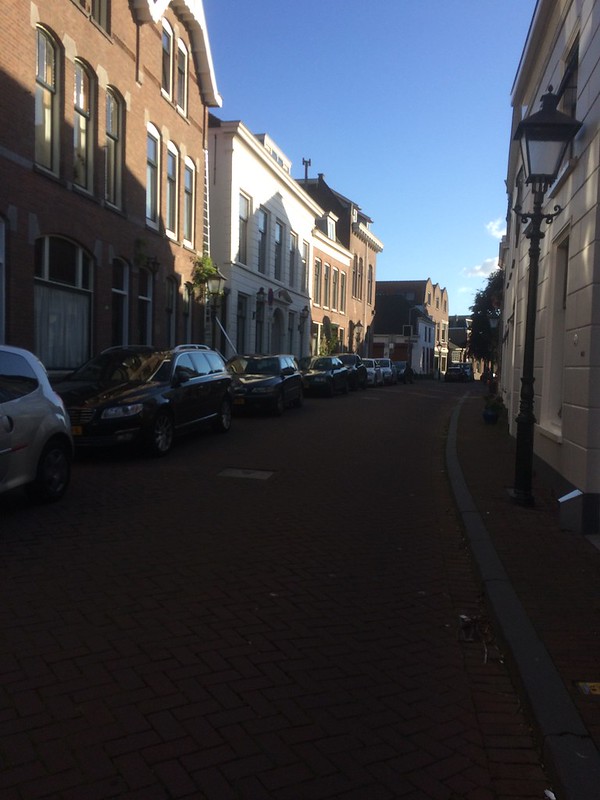Delft – Rotterdam Bicycle Highway
Ramzi Talhouk
The Route
There are two main bicycle highways between Rotterdam and Delft. One is more eastward, beginning near the Nieuwe Kerk in Delft, heading east into Delfgauw, and finally tuning south toward Rotterdam on Zuideindseweg, passing around the airport on the way. The other, which is the subject of this report, is slightly to the west. Beginning at the intersection of Julianalaan and Rotterdamseweg near the TU Delft campus, it follows Rotterdamsweg and Delftweg all the way to Rotterdam along the Schie canal before ending at the Maas tunnel, for a total distance of 15.7 kilometers. The route also connects Zwelth and Kandelaar – both of which lie on the Schie – to Rotterdam and Delft.
The Ride
Below is a map of the bicycle highway – which runs between the two green makers depicting bicycles – and a map of the route I rode while trying to follow the bicycle highway, which runs between the green bicycle marker in Delft and the red bicycle marker just outside of Rotterdam, a route that took me a total of 9.3 kilometers. The reason for my deviation from the correct bicycle highway was an inability to follow the bicycle highway due to a lack of prominent signage. This will be discussed later in the “Navigability” section.
Figure 1: Map of the Bicycle Highway
Ride Statistics
- Ride length: 9.3 km
- Yield Points: 3 (red pointers on map)
- Grade-separated Crossings: 3 (gold bridges on map)
- Signalized intersections: 1 traffic-metering signal
- Roundabouts: 0
- Cycle Track: 60%
- On-Street: 40%
- Lighting: Near 100%
Directness
The bicycle highway’s location along the country roads of Rotterdamseweg and Delftweg make it a very direct route between the two cities, as it used to be the main automobile route. However, when larger highways like the A13 and the A4 were built between the two cities, traffic was metered on Rotterdamseweg and Delftweg, reserving the road mainly for local traffic and cyclist looking for a direct route between Delft and Rotterdam.
In order to further improve the directness of this bicycle highway, there are no signalized intersections on the route between the two cities and barely any yield points, as is shown on the map. Any yield points that do exist did not cause me any delay as the traffic on the road is minimal. Moreover, there are several underpasses that further reduce delay for cyclists as it prevents them from having to negotiate large east-west flow roads such as the N470, the S114/N209, and the A20. Neither does passing through the villages of Zwelth and Kandelaar add any delay to the journey, as the bicycle highway follows the main street through town.
Safety and Comfort
The majority of the ride (about 60% as stated above), I was riding on smooth red cycle track that was vertically separated from the road by either parked cars or a grassy buffer (Figure 2). In these areas, it did not matter how much traffic there was on the road (although there was little).
Figure 2: Delft-Rotterdam Cycle Tracks
The remaining 40% of the route was on-street. Sometimes riding on rural road can be highly stressful for cyclists due to the high speed at which cars travel on such roads. The previously mentioned traffic metering works wonders in mitigating this issue along the Schie. However, traffic metering only controls the volume of traffic and does nothing to change the fact that the bicycle highway runs along a long straight road, perfect for high speeds. To combat this, much road of which the bicycle highway is a part of has advisory lanes, is paved in brick, or both (Figure 3). These pavement treatments are associated with bicycles and local streets respectively and therefore alert drivers to the possibility of encounters with bicycles. A decent portion of the on-street cycling along this highway is when passing through villages As a result of these efforts, I felt the environment was very safe and low-stress.
Figure 3: On-Street Pavement Treatments
Navigability
While I found many elements of the Schie bicycle highway well-designed and pleasant, I found it very difficult to navigate. Most of the route is on a straight road and is therefore not very difficult to follow. However, when there is a turn, it is not made obvious to cyclists where and when they should turn. I found only one sign helpful, which pointed the way to Rotterdam at the start of one of the on-street portions of the ride (Figure 4), and even that sign was quite small and could be easy to miss. The lack of signage eventually caused me to take a wrong turn near the Overschie neighborhood (the location is represented by an orange question mark on map above).
Figure 4: On-Route Signage
A street view of the intersection at which I made the wrong turn is shown in Figure 5. The street view represents the view of a cyclist approaching the intersection going from Delft to Rotterdam. Up to this point the cyclist has, for the most part, following a straight road. Therefore, when I approached this intersection, I instinctively went straight, as I did not think the bicycle highway continued down a very residential and local road. A road which, at first glance, looks like a dead end road on a map. Furthermore, the sign to the right of the intersection does not indicate in which direction is the route to Rotterdam. Instead, the arrows to the left mention other cities like Dordrecht. It was therefore not until I had traveled another kilometer or so beyond my wrong turn that I realized I had made one. I turned back and tried to find the correct route, but was unsuccessful. It was not until I spoke with classmates that I realized my mistake.
Figure 5: Location of my Wrong Turn
The Scenery
Transportation design aside, this was a very scenic and beautiful cycle route between Delft and Rotterdam. There were two places in particular that struck me as the most beautiful. Their locations are marked by green cameras on the map and their photos can be seen below.
The first spot that caught my eye was relatively early in the ride, just outside of Delft (Figure 6). The cycle track at this point runs along a series of polders, some filled with cows. I found this spot in particular so beautiful because it combines two things I have noticed and liked about the Netherlands. The first is the structure of their towns and cities: every city is very dense, which allows for continuous green spaces in between them. I noticed that here because in the background of the view, Rotterdam’s skyline can be seen over the country fields. This was something I found very beautiful. Secondly, I like the the Dutch seem to rely on fencing less when it comes to keeping their livestock from wandering. This is likely due to the dykes and waterways that surround most polders, but I like it because it makes me feel I am deeper in nature and less affected by humans.
Figure 6
The next spot that I stopped to admire was in the Overschie area (Figure 7). I enjoyed passing through all the villages I encountered on my ride. When entering them I feel as if I am in a different time; apart from the noise of modern cities, and back in a simpler time. This feeling is slightly ruined by the parked cars in this shot, but it is there nonetheless.
Figure 7
Conclusion
The bicycle highway between Delft and Rotterdam along the Schie canal is definitely a very direct and safe route for cyclists to travel between the two cities. Separated cycle tracks and metered traffic keep the route a good option for bicycles and a bad option for cars. The navigability leaves something to be desired, as there were very few signs, and none that were very large or clear. I wish I could have ridden the entire route in order to report on the portion that I missed. However, if one knows the way, they can easily get from Delft to Rotterdam on a bicycle.






